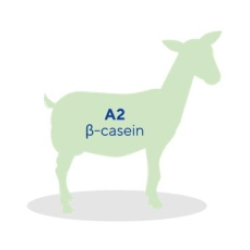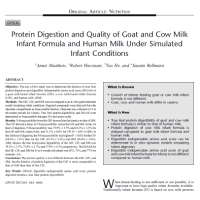
The easy digestion of Kabrita goat milk formula
Growth and development during the early phase of life are crucial for long-term health. Dietary protein requirements are at their highest during this early phase as proteins are building blocks for all tissues, including muscles and organs1. Moreover, most of the proteins have bioactive functions, given that proteins can facilitate the transport of minerals and vitamins, can be immunoregulating or can be antimicrobial2.
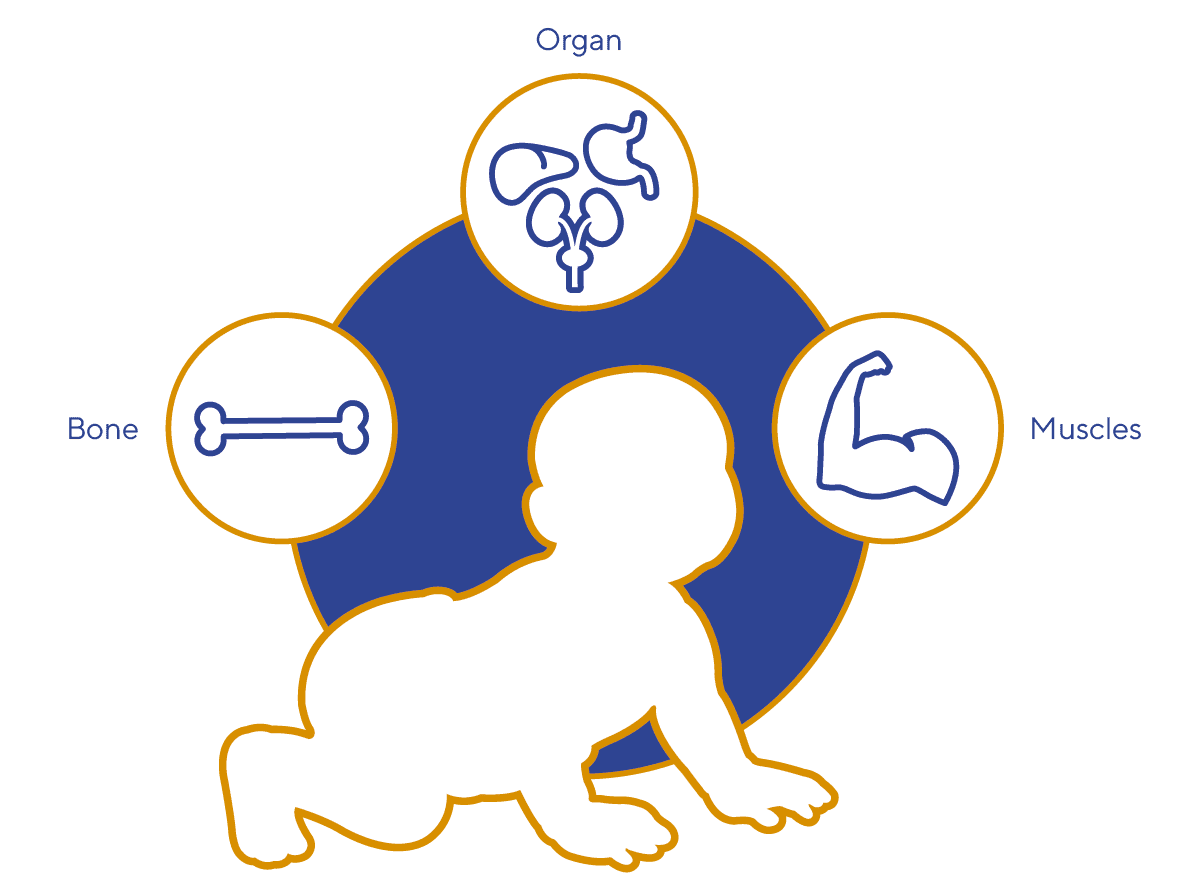
After ingestion, proteins are digested within the infant’s digestive tract and broken down into peptides and amino acids for absorption and utilization by the infant’s body3. The kinetics of protein digestion can be important for the comfort of the infants. The kinetics of protein digestion differ between human milk and different types of infant formulas. Human milk proteins are easiest to digest for infants while goat milk proteins are described as being more easily digested than cow’s milk proteins4-6.
Protein digestion kinetics of Kabrita
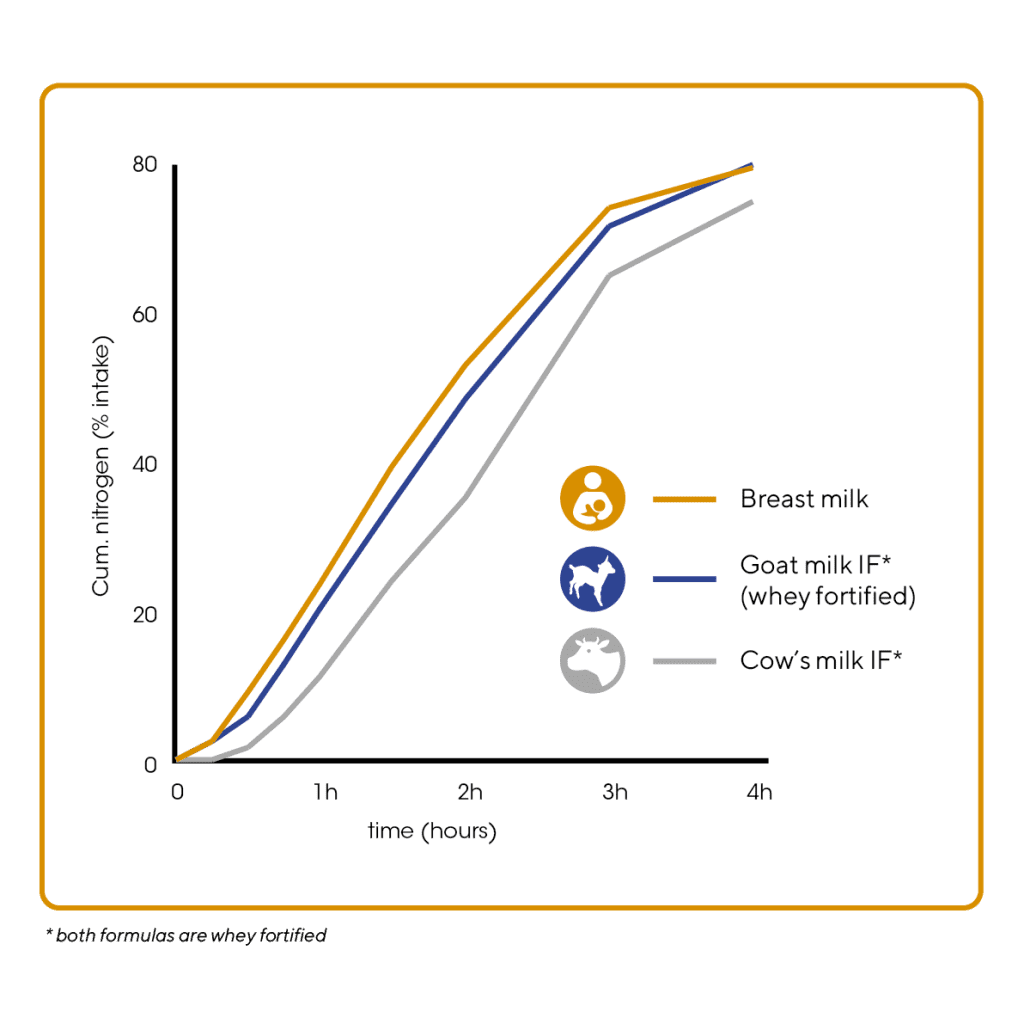
The protein digestion kinetics of Kabrita’s goat milk formula more closely resembles human milk protein kinetics than the kinetics of proteins from cow’s milk formula7. Kabrita goat milk formula contains proteins that are easier to digest compared to cow’s milk formula, possibly due to looser curds formation4,5.
Click on the paper below to learn more about this protein digestion kinetics study.

Looser curds of Kabrita

The looser curds of Kabrita in the stomach, as compared to cow’s milk formula, makes it easier to break down the proteins because the gastric enzymes such as pepsin have easier access to the proteins.4,5 Infants could benefit from the looser curds and easy digestion of goat milk proteins.
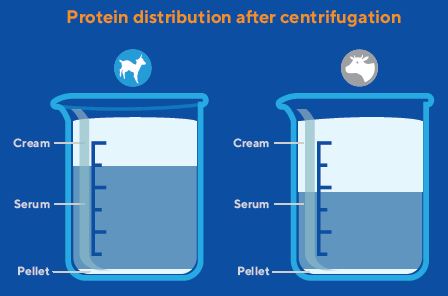
Ausnutria’s research team compared the digestion of Kabrita (goat milk formula, GMF), a cow’s milk formula (CMF) and human milk in a gastric model simulating infant’s conditions.10 A number of notable differences between Kabrita and CMF were observed, which may contribute to the observation that the protein digestion kinetics of Kabrita formula are more comparable to those of HM. This research confirmed that Kabrita formula forms looser and larger curds than CMF in the stomach. Moreover, this research showed that when an infant formula separated to serum and cream phase in the stomach, the proportion of proteins in the serum phase is higher in Kabrita formula than in CMF. Proteins in the serum phase may be more readily emptied from the stomach for further digestion, resulting in faster protein digestion.11
Click on the paper below to read more about the gastric protein digestion.

Paper: gastric protein digestion (He at al. 2021)

Infographic: gastric protein digestion
Reason why Kabrita shows looser curds
1) Goat milk has lower αs1-casein and higher β-casein levels than cow’s milk4,5.
There are different types of caseins in milk. αs1-casein is one of the caseins that is hardly present in human milk, while in goat milk around 6% and in cow’s milk around 38% of the total caseins are αs1-casein. Goat milk is also reported to have a higher level of β-casein than cow’s milk, which makes the casein profile of goat milk closer to the casein profile of human milk.

2) the structural difference between goat milk β-lactoglobulin and cow’s milk β-lactoglobulin8.
The whey protein in goat milk has been reported to be more easily digestible than cow’s milk whey protein. Goat milk β-lactoglobulin is structurally different from cow’s β-lactoglobulin, possibly making goat β-lactoglobulin less resistant to digestion.4 Laboratory testing showed that 77% of goat β-lactoglobulin is digested after treatment with gastric and intestinal juices, while only 17% of cow’s β-lactoglobulin was digested.9
Click on the infographic below for an overview why goat milk proteins are easier to digest.
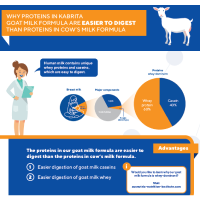
Infographic: why goat milk proteins are easier to digest
Kabrita has an adapted whey:casein ratio
The whey:casein ratio in human milk is around 90:10 during the first weeks after birth and decreases to 60:40 some 3-4 weeks after birth.3,12 The ratio of whey proteins and caseins in mature human milk remains around 60:40, indicating that infants have a natural need for nutrition with this whey:casein ratio of 60:40.13 Goat milk naturally has a whey:casein ratio of 20:80, like in cow’s milk. To closely resemble human milk, Kabrita infant formula has an adapted whey:casein ratio of 60:40 as is the ratio naturally present in human milk.

Whey proteins are also diverse, consisting of different types, such as α-lactalbumin, lactoferrin and immunoglobulins. These major whey proteins promote the immune system, which is important since the infants have an immature immune system.13,14 A higher proportion of whey proteins in infant formula may be beneficial as it provides higher levels of bioactive proteins such as lactoferrin, α-lactalbumin, osteopontin and immunoglobins. These bioactive proteins promotes immunomodulation and can offer protection against infections.13 Whey proteins may promote growth of beneficial bacteria in infant gut.15,16 Whey proteins are also source of amino acids which are important for muscle synthesis. Clinical evidence suggests that whey protein has the potential to increase muscle mass, which may be beneficial for a healthy body composition in infants.17 Goat whey, and in particular β-lactoglobulin, is reported to be easier to digest than cow’s whey.8,9 Higher levels of whey proteins support in these ways a healthy development of infants.
Easy digestion due to 60:40 whey:casein ratio

The whey:casein protein ratio impacts the digestibility of protein in infant formula and in this way may impact the digestive comfort of infants. The influence of whey:casein protein ratio (60:40, 40:60, 20:80) on the digestibility of has been studied in an in vitro digestion model.18 With a decreasing proportion of whey proteins, more extensive coagulation was observed, leading to significant reductions in protein and fat digestion. The digestibility of GMF with a whey:casein ratio of 60:40 and a GMF with a ratio of 20:80 has also been compared under gastric conditions in vitro. GMF with a whey:casein ratio of 60:40 showed less extensive coagulation or clotting of proteins and thus faster or easier digestion than the whey:casein ratio of 20:80.19 Another study showed that GMF with whey:casein a 60:40 ratio had lower gel strength (less force needed to break the proteins) than GMF with a 20:80 ratio, which may contribute to easier and/or faster digestion.20
Click on the infographic below to have a quick overview of the benefits of whey dominant formula.

Infographic: Whey dominant formula
Conclusion
During the early phase of life, infants can benefit from more easily digestible proteins, since their digestive system is still maturing. To maintain infant comfort, gentle nutrition with easy digestible proteins is preferred. Research shows that the protein digestion kinetics of Kabrita more closely resembles human milk protein kinetics than the kinetics of proteins from cow’s milk formula.7
References
- 1. Michaelsen, K.F. and F.R. Greer, Protein needs early in life and long-term health. Am J Clin Nutr, 2014. 99(3): p. 718s-22s.
- 2. Walther, B. and R. Sieber, Bioactive proteins and peptides in foods. Int J Vitam Nutr Res, 2011. 81(2-3): p. 181-92
- 3. Lönnerdal, B., Nutritional and physiologic significance of human milk proteins. The American journal of clinical nutrition, 2003. 77(6): p. 1537S-1543S.
- 4. Park, Y., et al., Physico-chemical characteristics of goat and sheep milk. Small Ruminant Research, 2007. 68(1): p. 88-113
- 5. Ceballos, L.S., et al., Composition of goat and cow milk produced under similar conditions and analyzed by identical methodology. Journal of Food Composition and Analysis, 2009. 22(4): p. 322-329
- 6. Inglingstad, R.A., et al., Comparison of the digestion of caseins and whey proteins in equine, bovine, caprine and human milks by human gastrointestinal enzymes. Dairy science & technology, 2010. 90(5): p. 549-563
- 7. Maathuis, A., et al., Protein Digestion and Quality of Goat and Cow Milk Infant Formula and Human Milk Under Simulated Infant Conditions. J Pediatr Gastroenterol Nutr, 2017. 65(6): p. 661-666.
- 8. Park, Y.W. and G.F.W. Haenlein, Handbook of milk of non-bovine mammals. 2nd ed. 2017, Ames, Iowa: Blackwell Pub.
- 9. Almaas, H., et al., In vitro digestion of bovine and caprine milk by human gastric and duodenal enzymes. International Dairy Journal, 2006. 16(9): p. 961-968.
- 10. He, T., et al., Gastric protein digestion of goat and cow milk infant formula and human milk under simulated infant conditions. Int J Food Sci Nutr, 2021: p. 1-11.
- 11. Golding, M. and T. Wooster, The in uence of emulsion structure and stability on lipid digestion. Current Opinion in Colloid & Interface Science, 2010. 15: p. 90-101.
- 12. Kunz, C. and B. Lonnerdal, Re-evaluation of the whey protein/casein ratio of human milk. Acta Paediatr, 1992. 81(2): p. 107-12.
- 13. Lönnerdal, B., Bioactive Proteins in Human Milk: Health, Nutrition, and Implications for Infant Formulas. J Pediatr, 2016. 173 Suppl: p. S4-9.
- 14 Lawrence, R.A. and R.M. Lawrence, Breastfeeding: a guide for the medical profession. 2011: Elsevier Health Sciences.
- 15 Balmer, S.E. and B.A. Wharton, Diet and faecal flora in the newborn: breast milk and infant formula. Arch Dis Child, 1989. 64(12): p. 1672-7.
- 16 Hascoët, J.M., et al., Effect of formula composition on the development of infant gut microbiota. J Pediatr Gastroenterol Nutr, 2011. 52(6): p. 756-62.
- 17. Hoppe, C., et al., The use of whey or skimmed milk powder in fortified blended foods for vulnerable groups. J Nutr, 2008. 138(1): p. 145s-161s.
- 18. Phosanam, A., et al., In vitro digestion of infant formula model systems: Influence of casein to whey protein ratio. International Dairy Journal, 2021. 117.
- 19. Ye, A., et al., Coagulation behaviour of milk under gastric digestion: Effect of pasteurization and ultra-high temperature treatment. Food Chem, 2019. 286: p. 216-225.
- 20. Wang, Y., et al., Rheological and structural characterization of acidified skim milks and infant formulae made from cow and goat milk. Food Hydrocolloids, 2019. 96: p. 161-170.107


